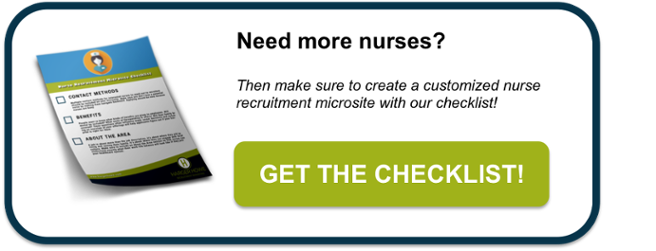AMN Healthcare provides excellent insights when it comes to nurse recruiting and retention strategies. I was pleased to note that two of their recent articles addressed the issues of nurse happiness and travel nurse utilization.
According to AMN’s article, “the Penn (Pennsylvania School of Nursing) team found that each additional patient per nurse was associated with a 6 percent to 9 percent increase in the odds of a patient’s readmission with 30 days, depending on the condition. [A] good nurse working environment [was] associated with 7 percent, 6 percent and 10 percent lower rates for heart failure, acute myocardial infarction and pneumonia, respectively.” The cost to bring on and maintain qualified nurses can be expensive in the short-term, but readmission rates are a bigger issue for hospitals considering that the Centers for Medicare and Medicaid Services is now monitoring and directly punishing healthcare institutions who are turning out high rates for, “heart failure, acute myocardial infarction and pneumonia” conditions.
Hiring more nurses and keeping them happy within their work environment allows you to retain talent and ultimately lower your recruitment costs. So what do nurses really want?
1. Respect and Recognition
Passionate nurses who provide the best care deserve to be recognized. Some ideas include a direct thank you from management, small gifts and tokens from supervisors and other less frequent, but more prestigious options such as The Daisy Award and other various nursing excellence awards.
2. The Opportunity to Innovate
As Donna Wilk Cardillo said, “nurses are the heart of healthcare.” Often, it is necessary for them to perform many roles. According to NursingTogether, some of these roles include: caregiver, decision-maker, communicator, manager of care, patient advocate and teacher. With all this patient contact, nurses have a wealth of knowledge that can contribute to innovative techniques and care options if they are given the chance to share. Many times, the improvement of patient outcomes is the result of the person who spends the most time with a certain population. Let your nurses speak up and help you to mold your healthcare policies and always make sure you tell them how much you appreciate their contributions.
3. Fair Compensation and Benefits
Nursing salaries vary widely from state to state, but data assembled by Nurse Journal from 2014 via three jobs boards: Indeed, Career Builder and SimplyHired suggests the average salary for a Registered Nurse is was $64,000 and the higher end of the spectrum (10%) made $94,000.
To be competitive, hospitals need to factor in cost of living and review their state pay levels. Though salary and benefits aren’t everything, they are one of the first things anyone looks for in a job.
4. Strong Leadership Mixed with Independence
Nurses are interested in working for healthcare institutions that provide strong direction, while simultaneously allowing them to thrive and make decisions. In the AMN article, Matthew D. McHugh states that, “nurses’ need to practice in an environment that reinforces their professional role and autonomy, provides adequate resources, demonstrates consistent and high-quality managerial support and leadership, and includes nursing in institutional decision making.”
--
In addition to addressing leadership, communication and compensation, nurse recruiters should consider how new nurse candidates find their health system. We create nurse recruitment microsites for our clients and have found them to be highly effective at removing the barrier that some applicant tracking systems (ATSs) can to pose to candidates.
Do you already have a nurse recruitment microsite? Are you interested in creating one? If so, try our Nurse Recruitment Microsite Checklist. It’s free!











